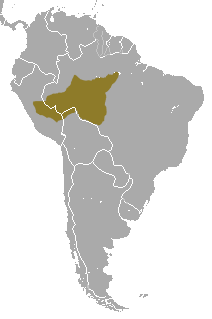Black-headed night monkey
| Black-headed night monkey[1] | |
|---|---|
 | |
| Scientific classification | |
| Domain: | Eukaryota |
| Kingdom: | Animalia |
| Phylum: | Chordata |
| Class: | Mammalia |
| Order: | Primates |
| Suborder: | Haplorhini |
| Infraorder: | Simiiformes |
| Family: | Aotidae |
| Genus: | Aotus |
| Species: | A. nigriceps |
| Binomial name | |
| Aotus nigriceps (Dollman, 1909) | |
 | |
| Black-headed night monkey range | |
The black-headed night monkey (Aotus nigriceps) is a night monkey species from South America. It is found in Brazil, Bolivia and Peru.[2] The A. nigriceps in Peru were notably inhabiting areas that were degraded, and often these areas were disturbed either by human activities or natural occurrences in the ecosystem.[3] A black-headed night monkey is about the same size as a small squirrel. Black-headed night monkeys have small ears that are hidden by their fur. When they become adults they are about 750g and usually are about 14 months old. Black-headed night monkeys have three black stripes that meet on their forehead. These monkeys have white patches by their eyes, cheeks, and under their mouth. Their eyes are very large and brown.[4]
Reproduction
[edit]A newborn usually weighs about 90 to 150g. Sexual maturity for males is at 2 years and for females is about 3 or 4 years. They occur in between August and February. A female only gives birth to one infant each year. The males are the primary care givers to the infants. The female starts biting the infants feet or tail about 2 weeks after so they go with the male and about 8 weeks they start to leave them.[4]
Behavior
[edit]Black-headed night monkeys live in small-family groups. Males attack other males and females attack the other females. These attacks can last in between 5 and 30 minutes. The reason why they attack is for territory. Whoever wins the attack gets to keep the territory along with any infants the losing pair have.[4]
Diet
[edit]Black-headed night monkeys are considered frugivorous. They usually eat leaves, flowers, moths, beetles and spiders.[4]
Names
[edit]It is called ausisiti in the Kwaza language of Rondônia, Brazil,[5] and nu’nu' in the Shawi language of Peru.[6]
Parasites
[edit]A. nigroceps suffers from Plasmodium brasilianum malaria.[7] P. brasilianum was first found in A. nigroceps by Araújo et al. 2013.[7]
References
[edit]- ^ Groves, C. P. (2005). Wilson, D. E.; Reeder, D. M. (eds.). Mammal Species of the World: A Taxonomic and Geographic Reference (3rd ed.). Baltimore: Johns Hopkins University Press. pp. 140–141. ISBN 0-801-88221-4. OCLC 62265494.
- ^ a b Shanee, S.; Alves, S.L.; Calouro, A.M.; Lynch Alfaro, J.W.; Romero-Valenzuela, D.; Messias, M.R.; Röhe, F.; Ravetta, A.L. (2021). "Aotus nigriceps". IUCN Red List of Threatened Species. 2021: e.T41542A190455194. doi:10.2305/IUCN.UK.2021-1.RLTS.T41542A190455194.en. Retrieved 20 November 2021.
- ^ Helenbrook, William. D.; Wilkinson, Madison L.; Suarez, Jessica A. (March 2020). "Habitat use, fruit consumption, and population density of the black-headed night monkey, Aotus nigriceps, in southeastern Peru". Acta Amazonica. 50 (1): 37–43. doi:10.1590/1809-4392201900172. ISSN 1809-4392.
- ^ a b c d Davis, Adam. "Aotus nigriceps black-headed night monkey". University of Michigan Museum of Zoology.
- ^ Manso, Laura Vicuña Pereira. 2013. Dicionário da língua Kwazá. M.A. dissertation. Guajará-Mirim: Federal University of Rondônia.
- ^ Rojas-Berscia, Luis Miguel. 2019. From Kawapanan to Shawi: Topics in language variation and change. Doctoral dissertation, Radboud University Nijmegen.
- ^ a b Pina-Costa, Anielle de; Brasil, Patrícia; Santi, Sílvia Maria Di; Araujo, Mariana Pereira de; Suárez-Mutis, Martha Cecilia; Santelli, Ana Carolina Faria e Silva; Oliveira-Ferreira, Joseli; Lourenço-de-Oliveira, Ricardo; Daniel-Ribeiro, Cláudio Tadeu (2014). "Malaria in Brazil: what happens outside the Amazonian endemic region". Memórias do Instituto Oswaldo Cruz. 109 (5). FapUNIFESP (SciELO): 618–633. doi:10.1590/0074-0276140228. ISSN 0074-0276. PMC 4156455. PMID 25185003. S2CID 14370475.


 French
French Deutsch
Deutsch